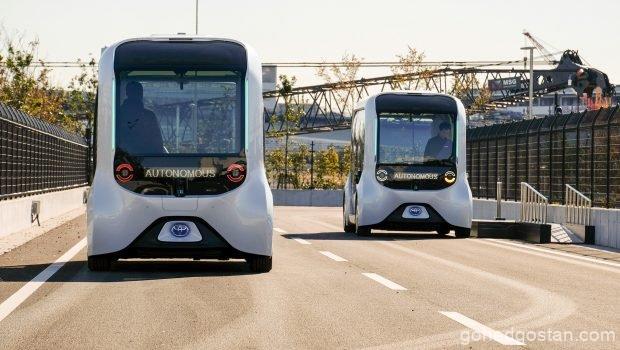Toyota Menyasarkan Guna e-Palette Secara Komersial
Toyota merancang untuk menggunakan e-Palette untuk penggunaan komersial dalam beberapa tahun sebagai sebahagian daripada matlamatnya untuk menyediakan perkhidmatan mobiliti baharu. Pertama kali diumumkan di Pameran Elektronik Pengguna/Consumer Electronics Show (CES) 2018 oleh Presiden Akio Toyoda, e-Palette adalah kereta panduan sendiri yang boleh berubah menjadi apa sahaja – pejabat, kedai bahkan hotel.
Setelah membuat penampilan sulung di Tokyo Motor Show tahun lalu, e-Palette bertujuan untuk digunakan sebagai mod pengangkutan untuk mengangkut atlet dan staf di kampung Olimpik dan Paralimpik di Sukan Olimpik dan Paralimpik Tokyo 2020 tetapi wabak COVID-19 telah memaksa pihak penganjur menangguhkan acara sehingga Julai 2021.


Untuk merealisasikan rancangannya untuk kegunaan komersial e-Palette, Toyota telah mengembangkan sistem pengurusan operasi berdasarkan ideologi Sistem Pengeluaran Toyota/Toyota Production System (TPS). Pada dasarnya, sistem ini akan memastikan kelancaran perkhidmatan dengan mengurangkan masa menunggu pelanggan dan mengurangkan kesesakan.
Salah satu komponen sistem pengurusan operasi adalah Autonomous Mobility Management System (AMMS), yang ditugaskan untuk menghantar kendaraan e-Palette bila diperlukan, jika diperlukan, dan jumlah yang diperlukan. Ia juga dapat mengubah jadual operasi dengan fleksibel, mengesan kelainan pada kendaraan, mengembalikannya ke depot dan mengirim kenderaan pengganti, dan menghentikan kenderaan semasa kecemasan.


Sementara itu, Platform Tugasan e-Palette (e-TAP) berfungsi sebagai fungsi pengurusan visual yang membolehkan seseorang untuk menguruskan beberapa kenderaan, dan bukannya satu orang secara berterusan memantau satu kenderaan.

Maklumat lebih lanjut mengenainya dalam siaran media mereka:
SIARAN MEDIA
Toyota Motor Corporation (Toyota) today announced an operations management system to support the providing of services that will enable practical use of the e-Palette, a battery-electric vehicle for autonomous mobility as a service (Autono-MaaS) applications*1 that will realize future mobility services. In collaboration with a range of partners, it is also planning to operate the vehicles in Woven City, a fully connected prototype city, while targeting commercial use in multiple areas and regions in the early 2020s.
When announcing his goal to transition Toyota to a mobility company at the January 2018 CES, President Akio Toyoda also announced the e-Palette as a symbol of mobility that goes beyond cars to provide customers services and new value. The e-Palette, with automated driving functions, had its debut at last year’s Tokyo Motor Show. It will provide a loop-line bus transportation service for athletes and related staff in the Olympic and Paralympic villages at the Olympic and Paralympic Games Tokyo 2020 that were postponed until July next year.

The spread of COVID-19 this past year has changed the way we live our lives, creating more diverse needs for mobility that include transportation that enables proper distancing between passengers, and a future of transportation of goods and services rather than people moving about. The shrinking and aging of society will also produce a range of mobility issues, so communities will increasingly need new mobility services, such as the e-Palette and other Autono-MaaS options, to address these issues.
To meet expectations such as these, Toyota aims to realize just-in-time mobility services that “go to where it is needed, when needed, and on time” and that provide the services and goods that are needed, when needed, and on time. To this end, it has developed an operations management system for e-Palette vehicles based on the Toyota Production System (TPS) ideology. This operations management system will be provided as new functions on Toyota’s Mobility Services Platform (MSPF)*2 and will consist of the Autonomous Mobility Management System (AMMS), for connecting to vehicles and the e-Palette Task Assignment Platform (e-TAP) for connecting to people. The system will reduce customer waiting times and alleviate congestion to ensures services provide safety, peace of mind and comfort.


With the aim of achieving the ultimate TPS-based just-in-time mobility service, AMMS is able to dispatch e-Palette vehicles when needed, where needed, and in the amount needed. Operation schedules can be changed flexibly, with vehicles automatically dispatched and returned, according to real-time mobility needs. When additional vehicles are introduced into a service, the intervals between vehicles are adjusted to ensure even spacing of services. Vehicle abnormalities are also automatically detected and, if that happens, the vehicles are automatically returned to the depot and replacement vehicles are immediately dispatched on the route to ensure stability of operation. In an emergency, the vehicles can be stopped and returned to service remotely, with an extra level of safety management, to provide passengers with peace of mind.
In line with the “Jidoka (automation with a human touch)” approach of TPS, e-TAP was introduced as a visual management function. Visualization of abnormalities in vehicles and workers enables a single person to manage several vehicles, rather than one person continually monitoring one vehicle, which enables operation with fewer workers. Work instructions are automatically provided to workers required for operation, including on-board operators and maintenance personnel. Task management including delay and front-loading enables shorter lead-times for maintenance and the provision of high-quality services even with limited workers.


Keiji Yamamoto, President of Toyota’s Connected Company, commented, “As per the Toyota Philosophy that President Akio Toyoda introduced at our recent financial results announcement, we see our vision as “Creating Mobility for All” and believe that every person working at Toyota should take action that delivers happiness to mankind in line with our mission of Producing Happiness for All. One of the platforms for executing these actions is the e-Palette. With the addition of an operations management system, the evolved e-Palette will be refined and will grow with the never-finished, ever-growing Woven City.”
Human-centric, Woven City is a prototype city for testing and developing technologies such as automated driving, MaaS, personal mobility, robotics, smart homes and artificial intelligence, with e-Palette vehicles planned for operation there. Operating within a real-world environment where people live will provide a range of lessons through which the platform will continually evolve to enable services that provide customers with safety, peace of mind and comfort. Going forward, Toyota aims to work with partners to commercialize the e-Palette vehicles in multiple areas and regions in the early 2020s.







No Comment